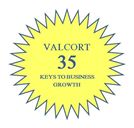Why selling your products is a bad idea
 Valcort 35 Keys to Business Growth: #4 Have a clear understanding of how each of your products and services relate to the other and to the company as a whole.”
Valcort 35 Keys to Business Growth: #4 Have a clear understanding of how each of your products and services relate to the other and to the company as a whole.”
I watched as my 10 year-old son dug around in a bin of hundreds of small and odd shaped little pieces. He turned a red plastic block in his hand – shiny, triangular, smaller than his fingernail. It was a cool shape. He studied it and quickly placed it on the growing geometry of blocks. He pulled out another piece, imagined it, then pushed it carefully and intentionally into just the right place.
Selling stuff
As business leaders, we often think of our products and services as “the stuff we make” or “the things we do.” Odd shapes, shiny objects, cool machines, interesting materials, special products or services — each with a particular value or function. We make stuff and sell stuff and our customers use our stuff. This is good. More importantly, you and your employees must know how your products and services work together to solve problems. If they don’t, you’re headed for trouble.
As long as you’re focused on selling products and features, you’re stuck. Commoditization is closer than you think. Focusing on products eventually leads to value being limited to price and features. While selling products and services is important, selling value is critical. Ultimately, simply selling products is an invitation for a competitor to match it, at a lower cost. It happens every day and you’ll never win the battle. And when products are the focus, it soon leads to a death spiral of price-chasing and cost reduction to compete. Selling products minimizes the real value of your company, your brands, your employees, your vendors, your stakeholders.
One client’s downward spiral
A few years ago a client in the automotive manufacturing business called asking us to help. A legacy company, they had made and sold a common and essential assembly to vehicle manufacturers. Every vehicle needed it. Over years, the company had focused on selling the product and relying on their relationships and brand recognition for new annual orders. With the entrance of global suppliers and Internet communication, our client soon found themselves losing share with dropping revenues and shrinking margins. They were in trouble.
As we spoke to their customers it became apparent they were buying an almost identical product much cheaper, but they were frustrated with the new supplier’s quality, their service and support, and limited parts availability in the U.S. market. Three attributes which our client already had strongly in place.
Our client had been focused on selling products for years, and completely missed the opportunity to sell a unique and highly-valued solution that differentiated them. After implementing our recommendations to sell a solution, sales dramatically increased, loyalty returned, and margins improved. And did so within 12 months!
Relieve your customers’ frustrations
In our research of hundreds of companies and brands, we know that most of the time customers are not really buying a specific product or SKU. Customers are buying a solution to a problem. And more importantly, we’ve found that most customers are willing pay a premium (more than you might guess!) if you can relieve their frustration and solve their pesky problem.
Unfortunately, many leaders, marketers and product developers are too focused on selling products and miss the bigger solution, leaving value, customer loyalty and profits behind.
Three steps to delivering value and growth
The true value of your organization to your customers and clients is not your products or services but the unique way you help your customers solve their problems. You solve them by 1) identifying your unique assets, 2) listening to your customers frustrations, and then 3) conforming, shaping and applying your products and services to address their problems. And this defines a unique value that only you can offer.
Set your self apart
No other organization has your people, with their unique experience, perspectives and abilities. No other organization has the same products and services, internal processes and systems to deliver quality and service effectively. No other organization has the leadership, vision and personality that your organization brings to the industry.
Your products, services, processes and people combine to make a compelling, premium solution that you only can offer. Each of these assets is unique and the whole is absolutely greater than the sum of the parts.
A critical practice for creating organic growth is understanding and articulating how each of your products, services, processes and people connect and interrelate to create a unique, compelling, high-value solution in the market. Without it, your customers will be lost and you’ll be stuck competing on price, not value.
The Valcort 35 Keys to Business Growth
Over many years and hundreds of client relationships and strategic marketing opportunities, we have established the Valcort 35 Keys to Business Growth, best practices that build trust, align values with products and practices, and create organic growth. We are exploring these 35 practices, one at a time, on these pages. Find them all, as they’re introduced, here.
Tags: products, solutions, Valcort, Valcort 35 Keys to Business Growth

